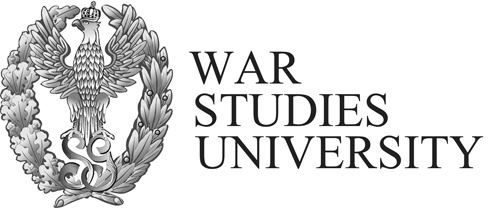Online first
Current issue
All issues
About
Aims and scope
Peer review process
Publication policy and ethics & malpractice statement
Editorial Board
Reviewers
Publisher
Guide for authors
Call for papers
Book Reviews
Special Issues Archive
New and emerging technologies in defence education, training and governance
RESEARCH PAPER
Selected models of information warfare in cyberspace
1
Wydział Zarządzania i Dowodzenia, Akademia Obrony Narodowej, Warszawa, Polska
2
War Studies University
Online publication date: 2017-03-21
Publication date: 2017-03-30
Security and Defence Quarterly 2017;14(1):35-50
KEYWORDS
ABSTRACT
One form of activity in cyberspace is the information battle. One of the proposed definitions
will define it as a negative co–operation in the sphere of information acquisition, information
distortion and information defense, where each side of the action is subordinated to the
antagonistic side of the other. It leads to the achievement of political objectives and is
aimed at overthrowing the systems of the state responsible for the state of its security. It is
important that this condition is at a high, or at least acceptable, level. To ensure this level,
it is important to define cybersecurity fighting models that are adequate for the threats and
to determine their impact on the level of national security risk in cyberspace. Literature on
the subject contains many models of cyberwarfare information that have been shaped in
recent years. However, there is no assessment of the adequacy of these models for the risks
and risks associated with national security threats. It should be noted that information
security itself, as part of national security, is variable. New threats are emerging and, at
a very high rate and with high activity in cyberspace, they are capable of destabilising the
security of key state administration bodies, military facilities and other important state–
run infrastructures. It should be emphasised that existing cyberspace fighting information models are not
universal and cannot be used for any type of threat to national security. They need to find,
organise and evaluate those that would be the most appropriate not only for national security threats but also for geopolitical determinants. Assumptions for the research and its results are a noticeable increase in the number of cyberattacks, some of which are important
from the point of view of national security – the military system and critical infrastructure
elements of the state. The following subject of the research was adopted in the article – models of information
fight, related to threats to national security coming from / to cyberspace. The purpose
of scientific research is to define models of information combat and to determine the
suitability and evaluation of these models for the purpose of evaluating the risks of national
security threats. Identifying the subject and objectives of the research led to a general
research question: What appropriate models of information fight in cyberspace can
be defined and used for the risks of national security threats? The research method
applied theoretical methods (analysis, synthesis, generalisation, abstraction, inference,
analogy and comparison) as well as the empirical method of dialogue and the method of
participant observation.
REFERENCES (14)
2.
J. Warden, The Enemy as System, Maxwell 1995, http://www.airpower.maxwell.af... airchronicles/apj/apj95/spr95_files/warden.htm [accessed: 23.04.2017].
3.
W. Krautz, Piąty wymiar walki, czyli logiczne konsekwencje modelu Wardena, http:// xportal.pl/?p=2110 [accessed: 28.06.2017].
4.
P. Sienkiewicz, Wizje i modele wojny informacyjnej [in:] Społeczeństwo informacyjne – wizja czy rzeczywistość?, Main Library of AGH University of Science and Technology, Cracow, 2003, p. 375.
5.
W. Scheffs, Automatyzacja działań urządzeń elektronicznych w środowisku cyberprzestrzeni i walki elektronicznej, Journal of KONBiN, 2011, 3(19), p. 127.
doi:10.2478/v10040-012-0037-1.
6.
Talassocracy – the term from ancient Greek, relating to countries wielding power at the sea. Thanks to the desired domination at the sea, they also have power on the land. Contemporary talassocracy means sea domination in the aspects of economy, economics, or the military.
7.
Tellurocracy – the term from ancient Greek, relating to countries wielding power and control on the land. Contemporary tellurocracy means land in the aspects of economy, economics, or the military.
8.
Dugin, A. Gieopolitikapostmoderna, (trans.) P. Sieradzan, Geopolityka, 1(2), 2009.
9.
M. Orzechowski, Koncepcja walki informacyjnej jako element bezpieczeństwa Federacji Rosyjskiej. Wojna w Donbasie jako study case zastosowania elementów walki informacyjnej [in:] Polska – Rosja, Polityka bezpieczeństwa Federacji Rosyjskiej, ed. M. Kaszub, M. Minkin, Wydawnictwo UPH, Siedlce, 2016, p. 105.
10.
J. Darczewska, Anatomia rosyjskiej wojny informacyjnej. Operacja krymska – studium przypadku, OSW, Warsaw, 2014, pp. 17–18.
13.
M.C. Libicki, What is Information Warfare?, National Defense University, Center for Advanced Concepts and Technology, Washington D.C., 1995, p. 1. doi:10.21236/ADA385640.
14.
J. Dereń, A. Rabiak, NATO a aspekty bezpieczeństwa w cyberprzestrzeni [in:] Cyberbezpieczeństwo jako podstawa bezpiecznego państwa i społeczeństwa w XXI wieku, M. Górka (ed.), Difin, Warsaw, 2014, p. 211.
CITATIONS (2):
1.
The threat of cyber attacks in urban conurbations
Marta Bachor
Security and Defence Quarterly
Marta Bachor
Security and Defence Quarterly
2.
Illusion of stability: An empirical analysis of inflation data manipulation by russia after 2022
Alex Plastun, Anna Vorontsova, Yaroslava Slyvka, Olha Yatsenko, Liudmyla Huliaieva, Victor Sukhonos, Ruslan Bilokin
Public and Municipal Finance
Alex Plastun, Anna Vorontsova, Yaroslava Slyvka, Olha Yatsenko, Liudmyla Huliaieva, Victor Sukhonos, Ruslan Bilokin
Public and Municipal Finance
Share
RELATED ARTICLE
We process personal data collected when visiting the website. The function of obtaining information about users and their behavior is carried out by voluntarily entered information in forms and saving cookies in end devices. Data, including cookies, are used to provide services, improve the user experience and to analyze the traffic in accordance with the Privacy policy. Data are also collected and processed by Google Analytics tool (more).
You can change cookies settings in your browser. Restricted use of cookies in the browser configuration may affect some functionalities of the website.
You can change cookies settings in your browser. Restricted use of cookies in the browser configuration may affect some functionalities of the website.




